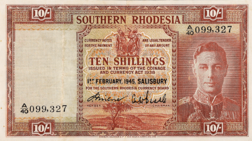Southern Rhodesian pound facts for kids
Quick facts for kids Southern Rhodesian pound |
|||
|---|---|---|---|
|
|||
| User(s) | Southern Rhodesia | ||
| Pegged with | sterling at par | ||
| Subunit | |||
| 1⁄20 | shilling | ||
| 1⁄240 | penny | ||
| Symbol | £ | ||
| shilling | s or /– | ||
| penny | d | ||
| Plural | pounds | ||
| penny | pence | ||
| Coins | 1⁄2d, 1d, 3d, 6d, 1/–, 2/–, 2/6 | ||
| Banknotes | 5/–, 10/–, £1, £5, £10 | ||
The pound was the money used in a country called Southern Rhodesia. It was also used in two other nearby places, Northern Rhodesia and Nyasaland. Think of it like how we have dollars or euros today! One pound was split into 20 shillings, and each shilling was then divided into 12 pence.
Contents
Money's Journey: A Brief History
For a long time, starting in 1896, private banks in Southern Rhodesia printed their own money. These notes were called pounds, shillings, and pence (often shortened to £sd). They were worth the same as the British pound, called sterling.
Then, in 1932, Southern Rhodesia started making its own special coins. A few years later, in 1938, a group called the Southern Rhodesia Currency Board was created. Their job was to take over printing all the paper money.
In 1953, Southern Rhodesia, Northern Rhodesia, and Nyasaland joined together. They formed a bigger group called the Federation of Rhodesia and Nyasaland. This new federation continued to use the Southern Rhodesian pound. But soon, in 1955, they started making new coins for a different currency, the Rhodesia and Nyasaland pound.
Also in 1955, the Southern Rhodesia Currency Board changed its name. It became the Central Africa Currency Board. By 1956, all the new paper money for the Rhodesia and Nyasaland pound was ready. This meant the old Southern Rhodesian pound was no longer used.
Cool Coins: What They Looked Like
The first special coins for Southern Rhodesia came out in 1932. These coins were made of silver and came in different values: 3 pence, 6 pence, 1 shilling, 2 shillings, and 2 shillings and 6 pence.
A couple of years later, in 1934, they added more coins. These were for half a penny and one penny. They were made of a metal called cupro-nickel and had a hole in the middle!
Over time, the materials used for coins changed. In 1942, bronze was used instead of cupro-nickel for some coins. The silver coins also changed in 1944. They used less silver in them. By 1947, cupro-nickel replaced silver for these coins. The last of these coins were made in 1954.
In 1953, a special 5-shilling silver coin was made. It celebrated 100 years since the birth of a famous person named Cecil Rhodes. Over 124,000 of these coins were made for people to use. A small number, 1,500, were also made as special collector's items called Proof coinage.
Paper Money: The Banknotes
The very first paper money in Southern Rhodesia was printed by private banks. In 1896, the Standard Bank of South Africa, which had a branch in Salisbury, printed £1 and £5 notes. Later, they also made 10-shilling notes. Other banks like the Bank of Africa, Barclays Bank, and the National Bank of South Africa also printed their own money. This practice of private banks printing money stopped in 1938.
In 1939, the Southern Rhodesia Currency Board took over. They started printing 10-shilling, £1, and £5 notes. Between 1943 and 1948, they also printed 5-shilling notes. In 1953, a £10 note was added.
After 1955, the Central Africa Currency Board continued to issue notes. These included 10-shilling, £1, £5, and £10 notes. Many of these banknotes featured images of important people like King George VI or Queen Elizabeth II. They also showed famous places in Southern Rhodesia, such as the Eastern Highlands, Victoria Falls, and Great Zimbabwe. Some notes even showed scenes of mining or animals like lions and elephants.
Images for kids




















